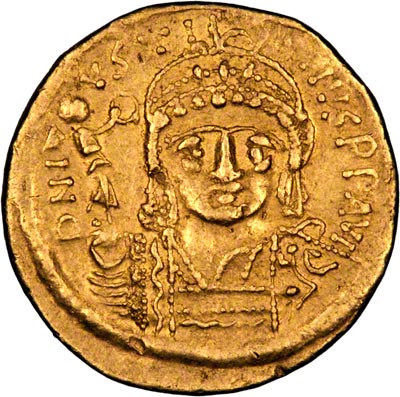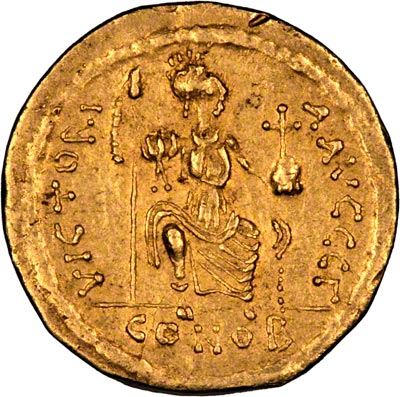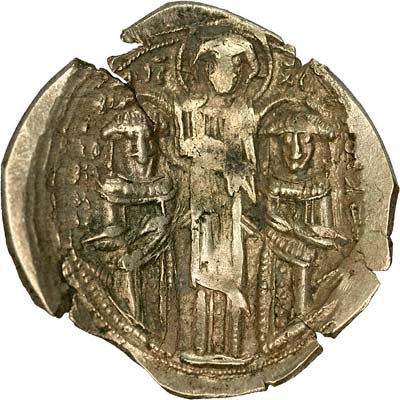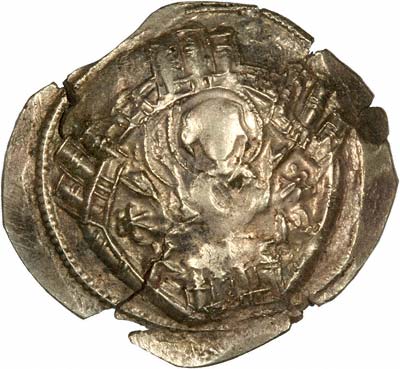| The Very Highest Quality Byzantine Coins |
| Byzantine Coins |
|
 |
  |
 |
The bronze coinage of the Byzantines is quite difficult to explain, as at various points, many different 'oddball' denominations were issued, sometimes worth as little as two nummii. However, the main denominations for the bronze issues were as follows:
40 Nummii (or 'Follis') denoted by the letter 'M'
20 Nummii (or 'Half-Follis') denoted by the letter 'K'
10 Nummii (or 'Decanummium') denoted by the letter 'I'
5 Nummii (or 'Pentanummium') denoted by the letter 'E'
Silver issues were fairly infrequent, but generally consisted of the Milianrense, Siliqua and fractions. The cup-shaped billon (less than 50% silver alloy) Aspron Trachy was introduced during the late 11th century, and during the later period, the Silver Stavatron was introduced, eventually becoming the highest denomination coin in Byzantium during the final, terminal years of the Empire's existence.
Gold, as previously mentioned, was initially based on the late Roman Solidus and its half and third fractions, which were discontinued in the late 9th century. Less than 100 years later, a lightweight Solidus, known as a tetarteron was introduced under Nikepheros II (963 – 969), ostensibly with the same face value as a full-weight solidus, but with a lesser gold fineness. This represented a blatant attempt by the Imperial authorities to cheat their subjects and foreigners with whom the Empire had trading links, but it did not work, and the coin was later revalued to be worth a quarter less than a Solidus (now known as a Histamenon Nomisma, to distinguish between the two types of Solidii).
Due to economic pressures and series of disastrous wars, both foreign and civil, during the 11th century, the gold content of the Histamenon and the Tetarteron was reduced to almost nothing. In 1092, the Emperor Alexios I attempted to restore public confidence in the integrity of the Byzantine currency by introducing the cup-shaped Hyperpyron, which was of the same standard weight as the old Histamenon (4.45 g) but of somewhat lower gold fineness (20.5 instead of 23.8 carats). However, even this coin was gradually debased until by the early 14th century, it was reduced to a mere 12 carats. By 1367, gold issues were discontinued and replaced with the Silver Stavraton as the highest value denomination, equal to two debased Hyperpyrons.
The last coins issued for the Byzantine Empire are the extremely rare silver Half-Stavrata of Constantine XI (1448 – 1453). By this point, the Empire barely stretched beyond the Walls of Constantinople, surrounded by the hostile Ottomans under Mehmed II who finally conquered the city in 1453.
However, a Byzantine style coinage carried on under the breakaway Empire of Trezibond until 1461, when it too fell to the Ottomans.
Individual Byzantine Coins For Sale (In chronological order)
Justin II Solidus 565 - 578
Andronicus II/Michael IX Hyperpyron 1295 - 1320
Order Form - UK
Order Form - USA
Order Form - EU
Order Form - Rest of World
Buying Coins
We also buy coins, please see our We Buy Coins page.
If you want to find the value of a coin you own, please take a look at our page I've Found An Old Coin, What's It Worth?
| ...at the Lowest Possible Price |
|
32 - 36 Harrowside, Blackpool, Lancashire, FY4 1RJ, England.
Telephone (44) - (0) 1253 - 343081 ; Fax 408058; E-mail: enquiries@24carat.co.uk The URL for our main page is: https://24carat.co.uk Web Design by Snoop |